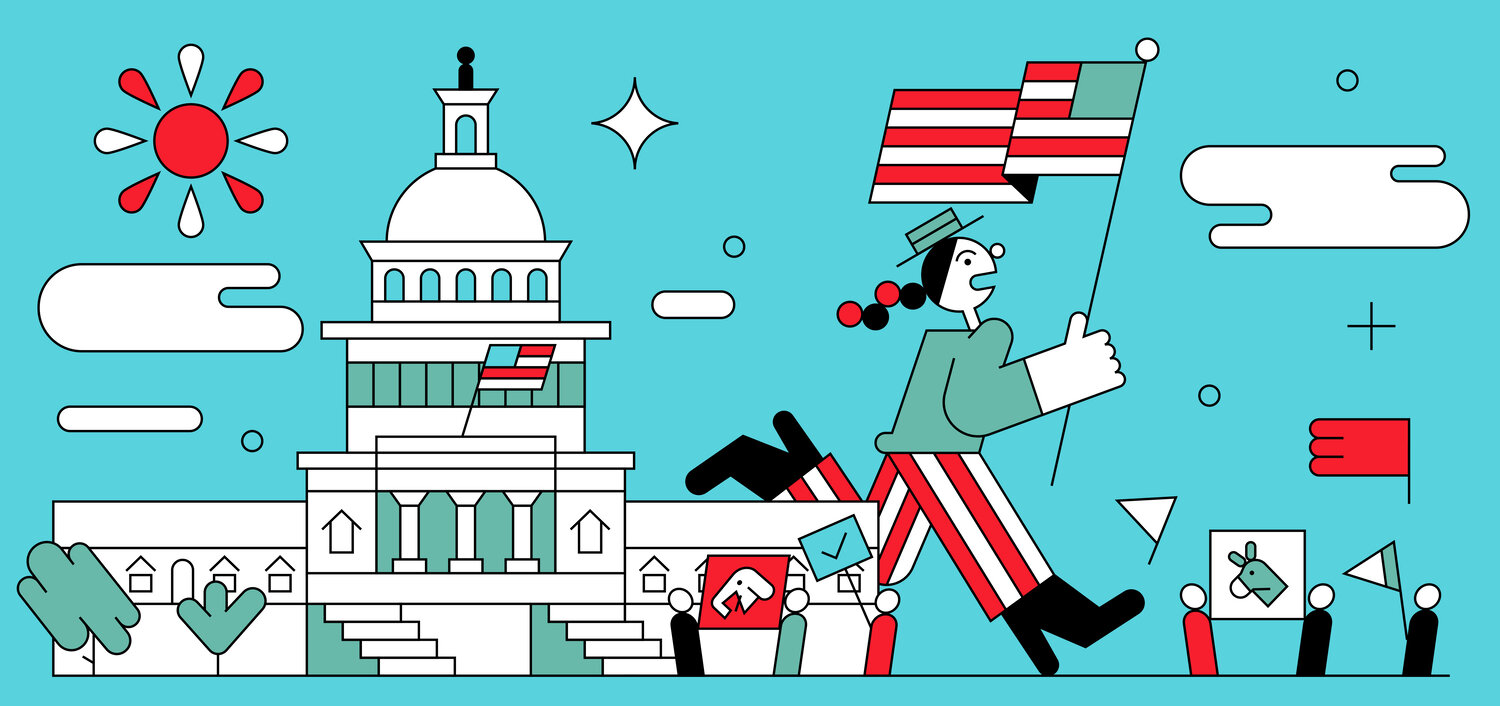No Polls. No Canvassing. No Rallies. How to Reach Voters When Your Campaign Suddenly Has to Rely on Social Media
Since our last post on Election 2020, U.S. cities large and small have been turned upside down by Coronavirus 2019 (COVID-19). Professional sports leagues have paused their seasons. The Olympics have been postponed an entire year. Schools are closed. Government buildings are closed to the public. Gyms and social spots are closed. Restaurants, if open at all, are pick-up and delivery only.
It was just a week and a half ago that residents of Teaneck, NJ were ordered to self-quarantine (NY Post). Today, that’s pretty much starting to be the norm, as people sacrifices their regular routines to #stayhome, #staysafe, #quarantineandchill.
In the state of Georgia where I live, multiple cities and counties are under curfews or shelter-in-place orders. In fact, my county just got locked down today.
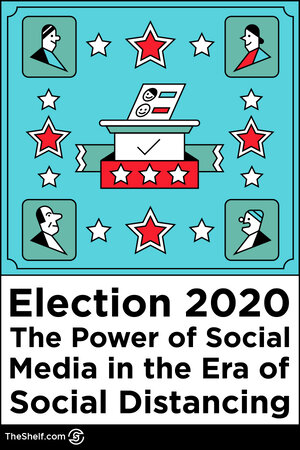
With so much going on and people being ordered to stay home and keep their distance from one another, political camps have stopped public rallies and campaigning door-to-door, which means candidates must now find ways to shift their campaigns online.

For the First Time In History, Presidential Campaigns Must Go Almost Completely Digital
I want to be clear: the endgame here is to lay out the basic elements of an effective influencer marketing strategy which high-profile political candidates can use to connect with younger voters WITHOUT risking their reputations and seeming weird or off-putting.
In this post, we’re going to analyze the social media activities of four political candidates to glean some cool takeaways about what works and what doesn’t when it comes time for esteemed, high-profile public figures to deploy effective social media campaigns.
In the next post for this series, we’ll break down some prescriptive strategies, but before we do that, I want to use this post to assess how four candidates used social media in the weeks leading up to Super Tuesday.
Let’s focus on Instagram for this post because the platform offers a nice cross-section of users from different age groups. And for targeting younger voters, it’s honestly the most conservative of the three social media platforms we would recommend (the other two being TikTok and Snapchat). So, Instagram it is.

Election 2020 Social Media Report Cards: What’s Working for Candidates on Social Media and What Isn’t
It seems like a lifetime ago now, but in the weeks leading up to Super Tuesday, we analyzed hundreds of Instagram posts from the campaigns of four presidential candidates:
- Joe Biden (still in the running for the Democratic nomination)
- Bernie Sanders (still in it… sorta)
- Mike Bloomberg (dropped out, now endorses Biden)
- Elizabeth Warren (dropped out out, offered no endorsements).
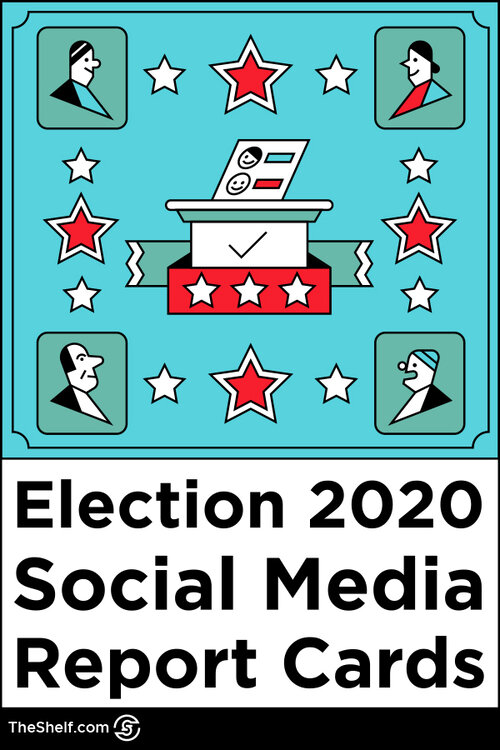
We wanted to get a clear picture of how the candidates were using social media during that critical four-week period in their respective campaigns.
Let’s get to it.
Bernie Sanders
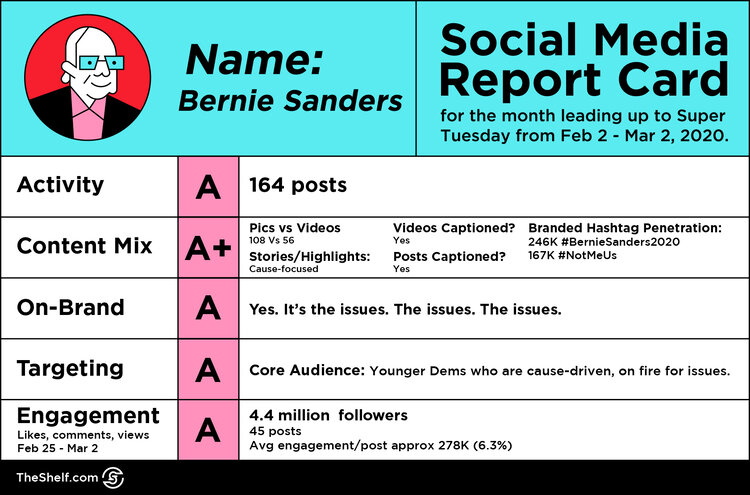
By far, the presidential candidate with the most interesting Instagram feed was (and is) Senator Bernie Sanders. More than just pictures from the campaign trail and videos of good points he may have made during the debates, the senator’s feed is a visual hodgepodge of retro graphics, hyper-targeted messages, and day-in-the-life content.
Admittedly, my first impression of his feed was that it reminded me one of those old, light blue brochures from Pueblo, Colorado – the ones that were always in municipal buildings or libraries back in the 90s.
Sanders’ IG feed seemed very old school, and not in an awesome, remaking-High-Fidelity-with-Zoe-Kravitz-as-Rob kinda way (“a Cosby sweataaaahhh!”).
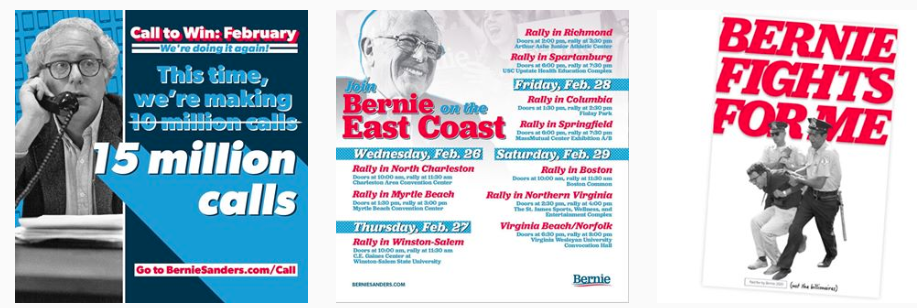
ACTIVITY
In the 29 days leading up to Super Tuesday, Bernie Sanders’ Instagram account published more than 160 in-feed posts for his 4.4 million followers (he has more than 4.7 million followers now). That amounts to about an average activity level for the four candidates (the Warren campaign published more than 200 posts during that same period while Biden’s camp published fewer than 75).
CONTENT MIX
The Sanders campaign produces a nice mix of content types for Instagram, from quotes and meme-styled graphics to fully-designed CTAs, videos, and Instagram Stories. AND the campaign is making good use of Stories and Highlights, featuring issues-focused pics and videos along the top of the senator’s feed. I think by now we all know Sanders is big on the issues. Issues, issues, issues!
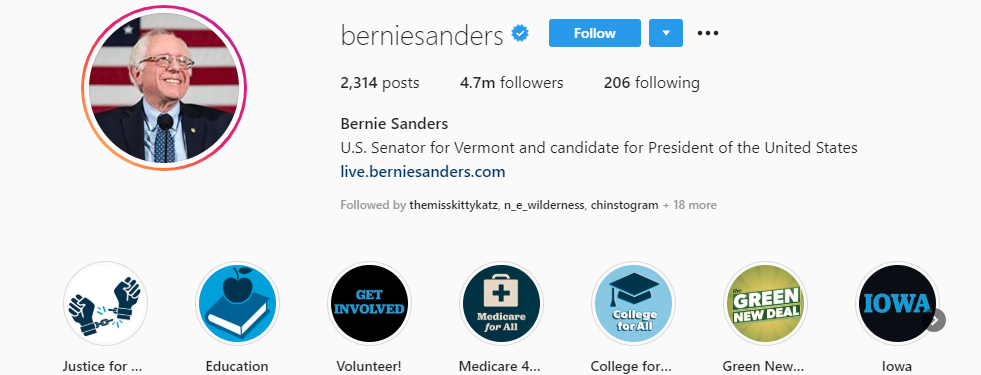
The Sanders campaign also had a couple of really popular branded hashtags circulating:
#Bernie2020 currently shows up in more than 287k posts (data in the graphic is from the beginning of March)
#NotMeUs shows up in more than 184k posts
TARGETING
The Sanders camp is doing a REALLY good job of targeting segments of Bernie’s audience with content, not just by age, gender and ethnicity, but also by behaviors, occupation, and values.
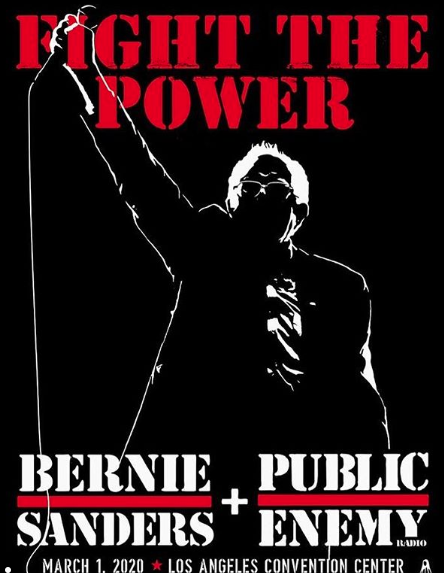
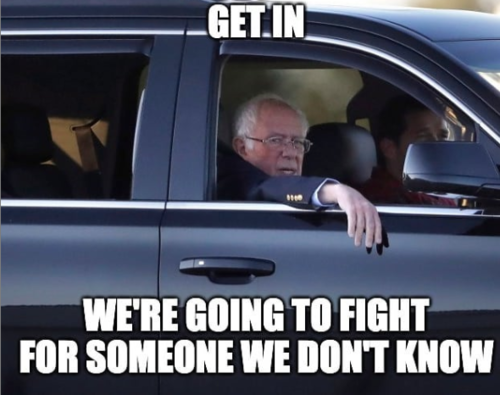
ENGAGEMENT
Of the four Instagram feeds we analyzed, Senator Sanders’ posts had the highest engagement ratio per post. Almost every post is tied to an issue or a message for a particular voter demographic. Take a look at the image above of Senator Sanders in the car. Rallying messages, war cries, calls-to-action show up frequently in the posts published to Sanders’ feed.
The result was above-average engagement. Posts generated an average of 278k actions taken by his followers every single time something posted to his account. That’s 6.3 percent engagement.
What I Would Keep and What I Would Optimize for Better Results
Keep
- The Sanders campaign has actually done an amazing job of ensuring the senator’s feed stands out from the other feeds, which stylistically speaking, are virtually indistinguishable from one another. (I mean, if you’ve seen somebody stand in front of *one* blue curtain…)
- Most of Sanders’ posts include emotive messages or strong CTAs. For example, one of his more emotive messages was a rallying cry to “never lose your sense of outrage” (<— post linked). Another post centered around little-known facts about same-day registration/voting in Michigan (FYI, I grew up in Michigan and didn’t realize that was a thing). These types of posts are powerful enough to evoke a strong enough emotional response for voters to take an action, even if that action is just engaging with the post. Plus, these give voters the proof they need to think of Bernie as someone who’s on their side.
- Most of the video content posted to Sanders’ feed is social proof from supporters, instead of just video footage of Bernie himself talking about topics.
- In lieu of long, stuffy explainer videos, the Sanders camp posts policies and updates as colorful, bite-sized illustrations that are easy to read.
Joe Biden
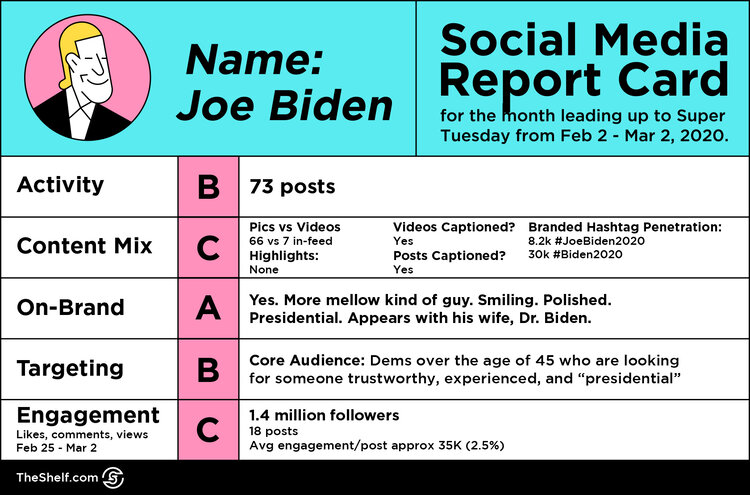
The most conservative of the four Instagram profiles we analyzed was the feed for Joe Biden. (Makes sense, right? He’s a pretty laid back guy.) The posts themselves were pretty run-of-the-mill for a political candidate. Most of them were pictures from the campaign trail, including lots of selfies with voters.
ACTIVITY
During the 29-day period leading up to Super Tuesday, Biden’s camp posted two or three times a day on average, for a total of 73 Instagram posts. To be clear, that’s A LOT of content, especially for feeds that aren’t specifically publishing news.
On the other hand, Biden’s camp published fewer than half the average amount of content that went live on the Instagram feeds of the other Democratic candidates. Less isn’t more for an Instagram campaign where brand awareness is the goal, especially when targeting a younger demographic. Remember: younger voters rely on social media as their primary news source.
CONTENT MIX
Both Sanders and Biden posted a mix of pictures, illustrations and videos. However, the content that went live on Biden’s feed was predominantly images and some [minimally-designed] graphics, not videos. Pictures outnumbered videos 9:1, and while there were some “illustrated” graphics, they were mostly message cards, screenshots of Biden’s tweets, and quote cards with dark blue backgrounds. There were no Stories and no Highlights.
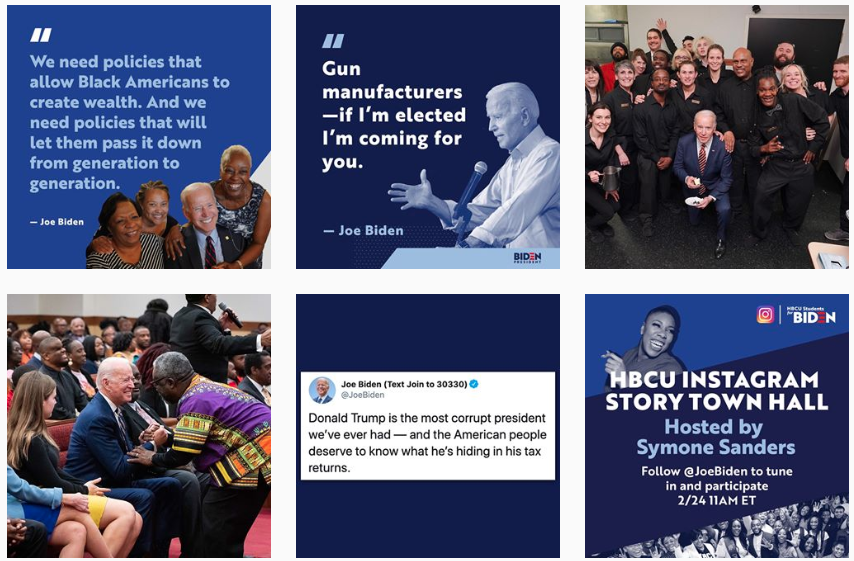
Like Sanders, Biden supporters are circulating a couple of branded hashtags:
#Biden2020 which now shows up in 36k Instagram posts
#JoeBiden2020 which shows up in 10k Instagram posts
TARGETING
The Biden campaign also does a good job of sharing content designed to target different segments of its audience, most notably minorities, women, and LGBTQ+ voters.
But I would be hard-pressed 😱 to pinpoint anything other than a post that mentions HBCUs (pictured above) that appeal to the 30 million Gen Z voters who will be between the ages of 18 and 24 when we head to the polls in November (Marketing Charts).
ENGAGEMENT
Engagement for Biden’s posts are around two percent, which is within the range of decent Instagram engagement for a following of that size. BUT we included in our measurement his thank you video for the win in South Carolina, which had well over a million views. It was that video alone which pushed the campaign’s Instagram engagement over the two percent mark.
What I Would Keep and What I Would Optimize for Better Results
Keep
- Posts targeting specific demographics are a great way to spread messages, establish commonalities on the basis of shared values, and add variety to an otherwise pretty humdrum Instagram feed.
- Pictures and videos with a spouse and/or pets is an easy way to add depth and that all-important human element to a feed (there are a couple of Biden and dogs – he says he wants to get pets back in the White House – haha).
- This merch ⬇️is hokey, and therefore…cool.
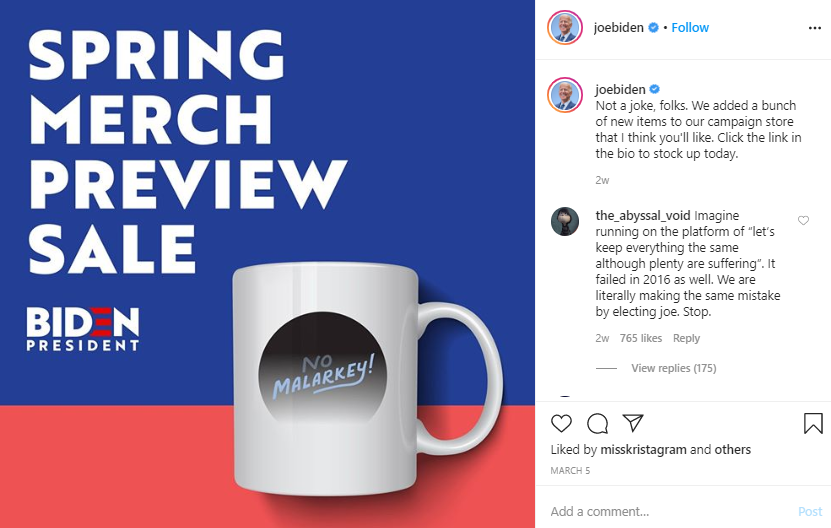
Optimize
- Incorporate more video into the content strategy. That can include more day-in-the-life content for both Mr and Dr. Biden (because she seems like she can slip into beast mode at ANY moment, as evidenced by this YouTube clip of the good doctor actually in beast mode.)
- There are creative ways to use Highlights. That could be the place for “Joe” content that’s not political (because Joe Biden is actually pretty hilarious).
- To improve the reach of each post, there’s no shame in leveraging the power of popular hashtags, man! For instance, when sharing policies that would benefit small businesses, get more eyes on your post by using relevant hashtags like #smallbusiness #shopsmall #hustle #agencylife #startups #creators. And you don’t absolutely have to sign everything with the tag of being Biden for President.
Elizabeth Warren
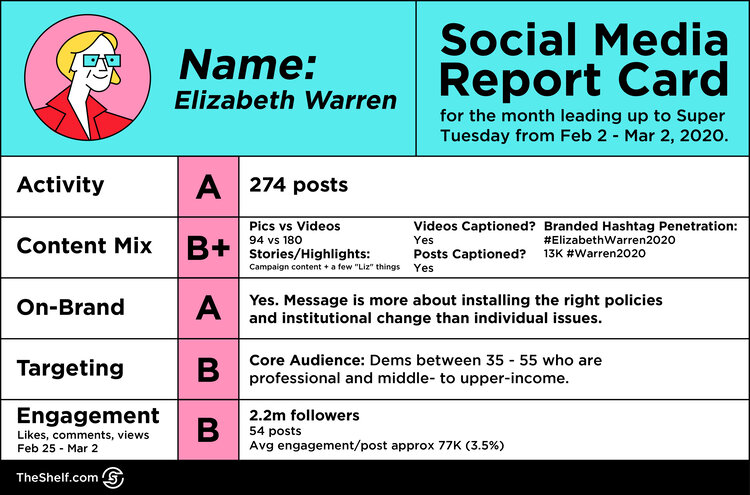
Senator Elizabeth Warren’s camp stayed busy posting to Instagram, publishing more in-feed content than Sanders’ and Biden’s camps combined ahead of Super Tuesday. The the feed generated the most content of either of the four social media accounts we reviewed.
ACTIVITY
In the four-week-period leading up to Super Tuesday, there were more than 270 in-feed posts that went live in Warren’s feed, in addition to Stories Highlights which featured videos from the campaign trail. Coolest thing: There was one Highlight dedicated to content about her dog, Bailey. 🙌 How very Instagram-y of you.
CONTENT MIX
With a 2:1 ratio of videos to images, there was a lot of multimedia content for voters to consume. Most of the videos were either of supporters offering their views on why Warren was their choice, or they were videos of the senator answering questions, making statements and giving speeches.
While the content mix was great, there was no distinguishable aesthetic, which made none of the posts really stand out.
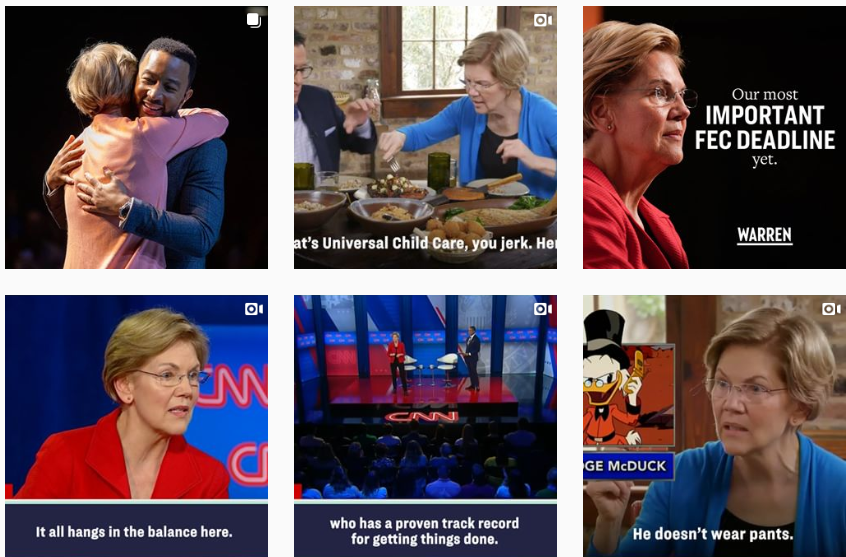
…. which is a shame because some of these videos (like this one eating with Stephen Colbert) would make fantastic tools for really breaking down policies so that voters really grok this stuff, and understand what’s at stake.
It’s hard to decide which video to click… if all the thumbnails look about the same. 😖 Not looking for that old-fashioned, full-posed 2016 Instagram aesthetic, but give the people SOMETHING.
The Warren campaign also had two branded hashtags floating around:
#ElizabethWarren2020 which showed up in 13k
#Warren2020 showed up in nearly 50k posts by March 2nd.
TARGETING
Like the previous two accounts we reviewed, Warren’s account featured instances of hyper-targeting, many of which were aimed at minorities and women (especially female entrepreneurs or professional women).
ENGAGEMENT
Overall engagement for Warren’s Instagram content was above-average for the week we measured it. The feed generated 77k instances of engagement per post (about 3.5% engagement). And Warren’s campaign made use of calls to action. Interestingly:
Senator Warren’s calls to action focused more on the continual efforts needed to make global and national changes from within the system. So, the underlying messaging was that by electing her, voters had a shot at getting problems like equal pay, and justice for border communities, and racial profiling fixed on an institutional level.
On the other hand, Sanders focused more on providing voters with what they could do in their communities and on their blocks to effect change and he would deliver the same gumption while in office.
A small shift in messaging – “watch me get it done for you” vs “let’s get it done together”. I actually believe that shift was one of the key factors that impacted engagement, and why Sanders’ followers engage nearly twice as much as Warren’s followers.
What I Would Keep and What I Would Optimize for Better Results
Keep
- Celebrity endorsements from well-liked (and well-respected) individuals like John Legend definitely won’t hurt. Just make sure they’re real fans so the endorsement doesn’t come off as fake.
- Change the thumbnails, but keep including the most compelling snippets of TV appearances and interviews as part of in-feed content (like the one I mentioned with Stephen Colbert); focus on clips where candidates aren’t on their soapboxes. Instead, share the content where they’re allowed to talk about issues in a relaxed environment. These kinds of opportunities can be powerful ways of adding depth to a candidate’s personality and making them more likable.
- The Highlights of Bailey the dog – awesome; isn’t it amazing how much more human having pets 🐶can make you seem?
Optimize
- Feeds should contain interesting content that’s visually appealing. If it’s interesting without being visually appealing, it’s hard to get new followers to stop scrolling long enough to check out the content. If it’s visually appealing but not interesting, people may follow, but you’re essentially teaching them not to waste their time clicking your posts.
- CTAs, wherever they may occur, work best when they’re actionable.
Mike Bloomberg
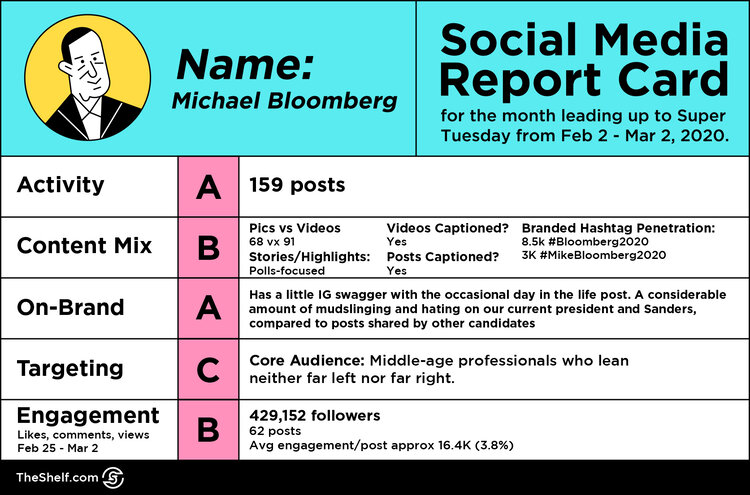
Mike Bloomberg, am I right? Smack-dab in the middle of the review period we designated for candidates, the memes showed up, and they were the type of content that could cause anyone to take a second look at the rest of Bloomberg’s social media posts… and so we did.
ACTIVITY
By March 2nd, Mike Bloomberg’s Instagram account had more than 429k followers. Of the four candidates, Bloomberg’s feed ranked third in frequency of posts, with 159 posts in the four weeks leading up Super Tuesday.
In the week leading up to Super Tuesday, however, Bloomberg’s camp published the most in-feed content at 62 posts.
CONTENT MIX
Bloomberg’s feed had about a 60-40 split between videos and images. He did make use of Stories Highlights. During our review period, the Highlights focused a lot on the polls and results of the primaries in each state (that content has since been removed and the Highlights are focused on national issues like the environment, gun laws, and education).
The campaign also had two branded hashtags circulating:
#Bloomberg2020 which showed up in more than 8500 posts
#MikeBloomberg2020 which showed up in about 3000 posts
TARGETING
Two things were striking about the Instagram activity on Michael Bloomberg’s account in the weeks leading up to Super Tuesday:
The first is that his Instagram feed focuses a lot on what he’s personally accomplished, even as the mayor of New York. (That makes sense, right? The man is pretty accomplished.) The problem with this strategy is that by focusing on his past and not the country’s future the feed all but confirmed the much-ballyhooed conversation around Bloomberg struggling to directly address and provide solutions for dealing with political issues.
The second thing of note was that many of the posts published to his feed were about the sitting president, which rallies together Trump’s detractors, but doesn’t necessarily call to arms Bloomberg supporters. There is a difference.
ENGAGEMENT
Bloomberg’s posts had the second highest engagement ratio at 3.8%. Each post that went live in-feed averaged over 16k instances of engagement.
What I Would Keep and What I Would Optimize for Better Results
Keep
- Bloomberg found his tribe, that group of people who knew of his success in post-911 New York City and could speak authentically and authoritatively about his accomplishments and capabilities.
- His narrative. Every superhero has a backstory. Bloomberg’s team made a valiant effort to endear him to people by sharing his story. * (leaving an asterisk here because we’ll come back to this in the Optimize section)
Optimize
- Minimize the mudslinging. It’s not a compelling enough reason for people to support you. It just boosts your engagement numbers among the other dissatisfied (and possibly angry) voters. That tactic works to raise awareness about wrongdoings and shortcomings, but it should be accompanied with strategies to fix what’s going wrong.
- *The campaign should have leaned into his nerd factor. Bloomberg is a numbers guy, but the campaign didn’t really dig into that aspect of his personality enough to help people connect the dots on why he seemed so… mmm… uhhh… so much like AI. (Haha. No disrespect, as a marketer, I dig his obsession with data). The sole purpose of telling a backstory is to humanize the protagonist, make him relatable. Shying away from this one particular personality trait that’s so much a part of his success, and has such a huge impact on his social style probably made him miss the rest of his tribe… which is basically the millions of people who also live by his mantra: In God we trust. Everyone else, bring data. #squad
- His green ties. That’s just a personality thing, and seems like it would have been interesting to latch on to.
- That human element. While New Yorkers could vouch for his awesomeness, the rest of us were like, “Does he seem a little weird to you?”. When people can’t aspire to your strength or relate to your weaknesses, they stammer to find the right words to describe you and finally settle on terms like “AI”. This guy would have been a prime candidate for the 100 podcasts in 100 days idea I shared in the last post.
Lay the Right Groundwork While You’re in the Background
While the media’s taking a break from holding presidential candidates under a microscope, it’s a good time for campaign organizers to focus on building strong social media strategies. Social distancing is making the traditional campaign trail a thing of the past, and even when the restrictions wear off, there may still be some lingering reluctance to gather for rallies.
A strong social media strategy that includes influencers as part of the game plan will do a couple of important things:
- Help candidates stay top-of-mind
- Give them platforms for presenting new ideas
- Enable them to engage in an environment they themselves can control
- Help people connect on the basis of ideas, values, and policies
Social media’s the only game in town, man. Play to win. The Shelf team knows how to help you do just that.


